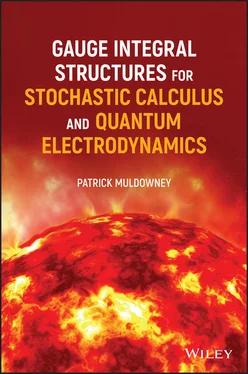Patrick Muldowney - Gauge Integral Structures for Stochastic Calculus and Quantum Electrodynamics
Здесь есть возможность читать онлайн «Patrick Muldowney - Gauge Integral Structures for Stochastic Calculus and Quantum Electrodynamics» — ознакомительный отрывок электронной книги совершенно бесплатно, а после прочтения отрывка купить полную версию. В некоторых случаях можно слушать аудио, скачать через торрент в формате fb2 и присутствует краткое содержание. Жанр: unrecognised, на английском языке. Описание произведения, (предисловие) а так же отзывы посетителей доступны на портале библиотеки ЛибКат.
- Название:Gauge Integral Structures for Stochastic Calculus and Quantum Electrodynamics
- Автор:
- Жанр:
- Год:неизвестен
- ISBN:нет данных
- Рейтинг книги:3 / 5. Голосов: 1
-
Избранное:Добавить в избранное
- Отзывы:
-
Ваша оценка:
Gauge Integral Structures for Stochastic Calculus and Quantum Electrodynamics: краткое содержание, описание и аннотация
Предлагаем к чтению аннотацию, описание, краткое содержание или предисловие (зависит от того, что написал сам автор книги «Gauge Integral Structures for Stochastic Calculus and Quantum Electrodynamics»). Если вы не нашли необходимую информацию о книге — напишите в комментариях, мы постараемся отыскать её.
, left off,
introduces readers to particular problems of integration in the probability-like theory of quantum mechanics. Written as a motivational explanation of the key points of the underlying mathematical theory, and including ample illustrations of the calculus, this book relies heavily on the mathematical theory set out in the author’s previous work. That said, this work stands alone and does not require a reading of
in order to be understandable.
Gauge Integral Structures for Stochastic Calculus and Quantum Electrodynamics Stochastic calculus, including discussions of random variation, integration and probability, and stochastic processes. Field theory, including discussions of gauges for product spaces and quantum electrodynamics. Robust and thorough appendices, examples, illustrations, and introductions for each of the concepts discussed within. An introduction to basic gauge integral theory. The methods employed in this book show, for instance, that it is no longer necessary to resort to unreliable «Black Box» theory in financial calculus; that full mathematical rigor can now be combined with clarity and simplicity. Perfect for students and academics with even a passing interest in the application of the gauge integral technique pioneered by R. Henstock and J. Kurzweil,
is an illuminating and insightful exploration of the complex mathematical topics contained within.


 where
where  or
or  . In fact the Riemann‐complete integral can be defined in terms of suitably chosen finite samples
. In fact the Riemann‐complete integral can be defined in terms of suitably chosen finite samples  of the elements in the domain of integration, without resort to measurable functions or measurable subsets—or even without explicit mention of subintervals of the domain of integration.
of the elements in the domain of integration, without resort to measurable functions or measurable subsets—or even without explicit mention of subintervals of the domain of integration. above—no matter how complex their construction—the only requirements are:
above—no matter how complex their construction—the only requirements are: and a process of selecting samples of points or elements of
and a process of selecting samples of points or elements of  —without reference to measurable subsets, or even to intervals of
—without reference to measurable subsets, or even to intervals of  at the most basic level.
at the most basic level. , 964, and 65 of [MTRV]) wwynman integrals.
, 964, and 65 of [MTRV]) wwynman integrals.

 is a random or unpredictable quantity, depending in a particular manner on unpredictable entities
is a random or unpredictable quantity, depending in a particular manner on unpredictable entities  and
and  ; and where
; and where
 depends on time t . In textbooks, the integrand is usually presented as
depends on time t . In textbooks, the integrand is usually presented as  , but
, but  is used here in order to emphasise that the integrand is intended to be random.
is used here in order to emphasise that the integrand is intended to be random. (or, when appropriate,
(or, when appropriate,  ) is to be regarded as a measurable function—as is
) is to be regarded as a measurable function—as is  —with respect to a probability space
—with respect to a probability space  .
.










